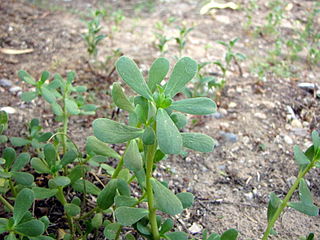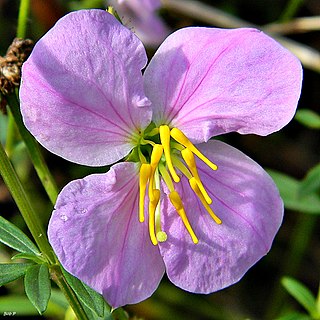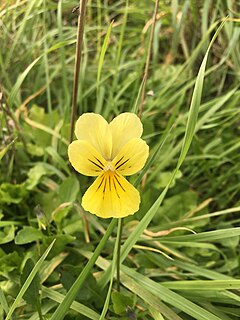
Reseda, also known as the mignonette, is a genus of fragrant herbaceous plants native to Europe, southwest Asia and North Africa, from the Canary Islands and Iberia east to northwest India. The genus includes herbaceous annual, biennial and perennial species 40–130 cm tall. The leaves form a basal rosette at ground level, and then spirally arranged up the stem; they can be entire, toothed or pinnate, and range from 1–15 cm long. The flowers are produced in a slender spike, each flower small, white, yellow, orange, or green, with four to six petals. The fruit is a small dry capsule containing several seeds.

Portulaca oleracea is an annual succulent in the family Portulacaceae, which may reach 40 cm (16 in) in height. Approximately forty cultivars are currently grown.

Nelumbo lutea is a species of flowering plant in the family Nelumbonaceae. Common names include American lotus, yellow lotus, water-chinquapin, and volée. It is native to North America. The botanical name Nelumbo lutea Willd. is the currently recognized name for this species, which has been classified under the former names Nelumbium luteum and Nelumbo pentapetala, among others.

Betula alleghaniensis, the yellow birch or golden birch, is a large and important lumber species of birch native to North-eastern North America. Its vernacular names refer to the color of the tree's bark. The name Betula lutea was used expansively for this tree but has now been replaced.

Neptunia lutea, commonly called the yellow-puff, is an herbaceous plant in the legume family (Fabaceae). It is native to the United States, where it is primarily found in the South Central region, extending eastward into the Blackland Prairies of Alabama and Mississippi. Its natural habitat is in open areas such as prairies and savannas. It is tolerant of disturbed soil.

Canna indica, commonly known as Indian shot, African arrowroot, edible canna, purple arrowroot, Sierra Leone arrowroot, is a plant species in the family Cannaceae. It is native to much of South America, Central America, the West Indies, and Mexico. It is also naturalized in the southeastern United States, and much of Europe, sub-Saharan Africa, Southeast Asia, and Oceania. Canna indica has been a minor food crop cultivated by indigenous peoples of the Americas for thousands of years.

Portulaca grandiflora is a succulent flowering plant in the family Portulacaceae, native to Argentina, southern Brazil, and Uruguay and often cultivated in gardens. It has many common names, including rose moss, eleven o'clock, Mexican rose, moss rose, sun rose, rock rose, and moss-rose purslane.

Viola lutea, also known as the mountain pansy, is a species of violet that grows in Europe, from the British Isles to the Balkans.

Sternbergia lutea, the winter daffodil, autumn daffodil, fall daffodil, lily-of-the-field, or yellow autumn crocus, is a bulbous flowering plant in the family Amaryllidaceae, subfamily Amaryllidoideae, in the Narcisseae tribe, which is used as an ornamental plant. It has yellow flowers which appear in autumn.

Rhexia is a genus of flowering plants in the family Melastomataceae. Rhexia species are commonly called "meadow beauty" and 11 to 13 species of Rhexia have been recognized depending on different taxonomic treatments.

Portulaca pilosa is a species of flowering succulent plant in the purslane family, Portulacaceae, that is native to the Americas. Its common names include pink purslane, kiss-me-quick and hairy pigweed. Its range extends from the southern United States and the Caribbean as far south as Brazil. It is a succulent with linear leaves and pink flowers.

Pinguicula lutea, commonly known as the yellow butterwort, is a species of warm-temperate carnivorous plant in the family Lentibulariaceae. It grows in savannas and sandy bog areas of the Southeastern United States.
Aletris bracteata is a plant species native to southern Florida and to the Bahamas. It grows in the Everglades and other wet areas very close to sea level. Some hybridization between this species and the yellow-flowered A. lutea has been noted.

Melaleuca lutea is a plant in the myrtle family, Myrtaceae and is endemic to Western Australia. This species was previously known as Melaleuca citrina but was renamed to allow Callistemon citrinus to be moved to the genus Melaleuca. It is distinguished by its oval shaped, dense heads of yellow flowers and bushy foliage.

Cordia lutea, known as yellow cordia or in Spanish muyuyo, is a shrubby plant in the borage family (Boraginaceae), native to the Galápagos Islands, mainland Ecuador, Peru, and the Marquesas Islands in Polynesia. Common in the arid lowlands of the Galápagos, its relatively large yellow flowers make it easy to identify.
Portulaca molokiniensis, known also as 'ihi, is a succulent plant endemic to Hawaii. This plant is federally listed as an endangered species. It has small yellow flowers and when grown from seed may produce a caudex. This plant is easy to propagate.
Catananche lutea, is a woolly annual plant, assigned to the daisy family, with most leaves in a basal rosette, and some smaller leaves on the stems at the base of the branches. Seated horizontal flowerheads develop early on under the rosette leaves. Later, not or sparingly branching erect stems grow to 8–40 cm high, carrying solitary flowerheads at their tips with a papery involucre whitish to beige, reaching beyond the yellow ligulate florets. Flowers are present between April and June. This plant is unique for the five different types of seed it develops, few larger seeds from the basal flowerheads, which remain in the soil, and smaller seeds from the flowerheads above ground that may be spread by the wind or remain in the flowerhead when it breaks from the dead plant. This phenomenon is known as amphicarpy. The seeds germinate immediately, but in one type, germination is postponed. It naturally occurs around the Mediterranean. Sources in English sometimes refer to this species as yellow succory.

Porites lutea is a species of stony coral in the family Poritidae. It is found growing in very shallow water on reefs in the Indo-Pacific region. It sometimes forms "microatolls" in the intertidal zone and these massive structures have been used to study trends in sea levels and sea water temperature.

Viola lutea subsp. calaminaria is a subspecies of V. lutea, in the violet family, the Violaceae. The plant occurs from Kelmis in the Belgian province of Liège across the borders to Germany and the Netherlands. The plant has adapted to an excess of zinc in the tailings of a former mines, the heaps of stone left over after separating the valuable fraction of ore. By evolving the ability to cope with the toxic heavy metal pollution, this violet has gained an advantage over the other plants in the ecosystem, as is able to become the locally dominant floral component of such habitats.
















